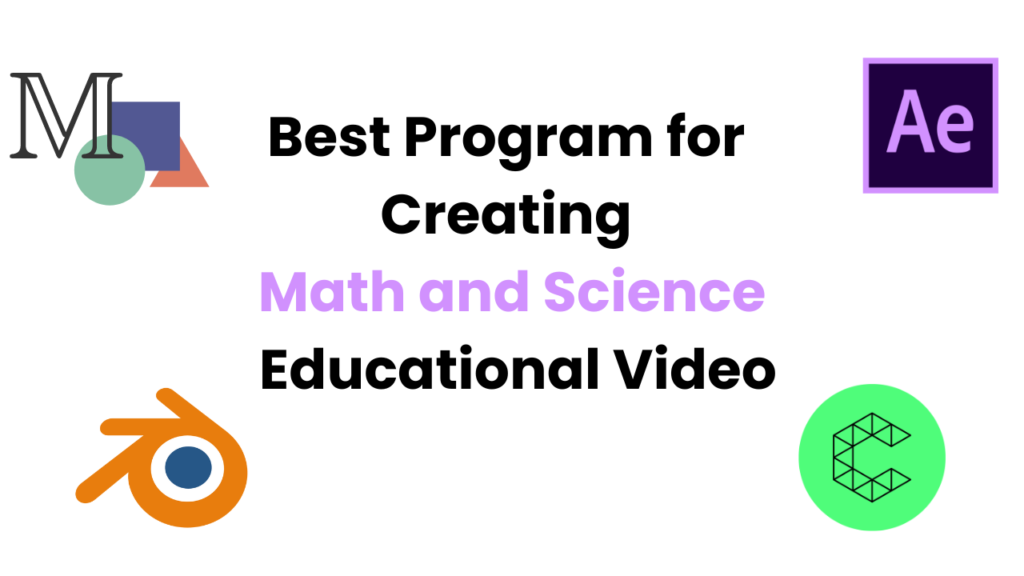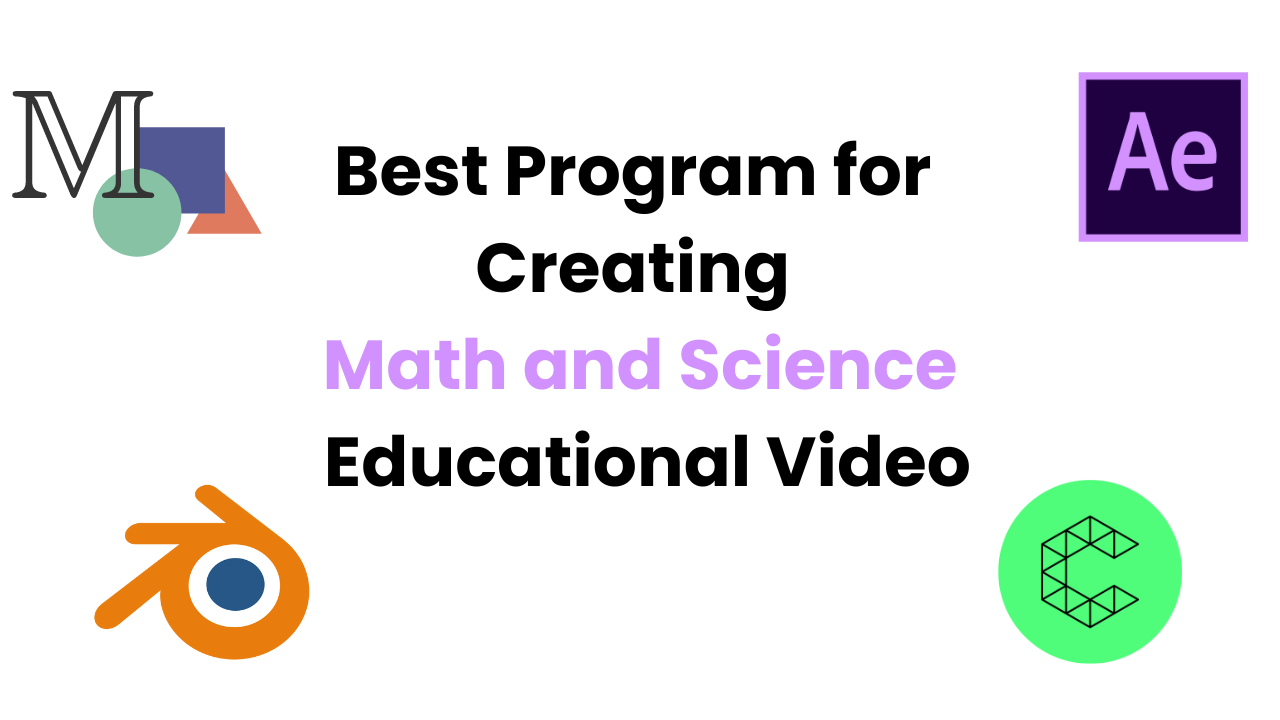In this blog we will see what are the some program available in the market to create cool Math and Science Educational video

- Manim

Manim is an engine for precise programmatic animations, designed for creating explanatory math videos.
Manim, short for “Mathematical Animation Engine,” is a powerful Python library for creating mathematical animations. Developed by Grant Sanderson, the creator of the popular YouTube channel 3Blue1Brown, Manim has gained popularity for its ability to produce high-quality animations that help visualize complex mathematical concepts.
One of the key features of Manim is its flexibility. Unlike many animation software that are designed for general-purpose animation, Manim is specifically tailored for mathematical and scientific animations. This makes it an ideal choice for educators and content creators looking to create educational videos in subjects like mathematics, physics, and computer science.
Manim’s strength lies in its ability to animate mathematical expressions and equations in a way that is both visually appealing and easy to understand. For example, you can use Manim to create animations that demonstrate geometric principles, such as the Pythagorean theorem or the properties of different shapes.
Another advantage of Manim is its open-source nature. This means that anyone can use, modify, and contribute to the development of the library. As a result, there is a vibrant community of users who share their creations, tips, and tricks, making it easier for newcomers to get started with the software.
Additionally, Manim integrates well with other Python libraries, such as NumPy and Matplotlib, allowing you to easily incorporate data visualization and computational tools into your animations.
In conclusion, Manim is a fantastic choice for creating educational videos, especially in the fields of mathematics and science. Its flexibility, ease of use, and vibrant community make it a valuable tool for educators and content creators looking to engage and educate their audience through captivating animations.
Note, there are two versions of manim. This repository began as a personal project by the author of 3Blue1Brown for the purpose of animating those videos, with video-specific code available here. In 2020 a group of developers forked it into what is now the community edition, with a goal of being more stable, better tested, quicker to respond to community contributions, and all around friendlier to get started with. See this page for more details.
Want to Learn Manim here are some source
2. Blender
Blender is the free and open source 3D creation suite. It supports the entirety of the 3D pipeline—modeling, rigging, animation, simulation, rendering, compositing and motion tracking, even video editing and game creation. Advanced users employ Blender’s API for Python scripting to customize the application and write specialized tools; often these are included in Blender’s future releases. Blender is well suited to individuals and small studios who benefit from its unified pipeline and responsive development process. Examples from many Blender-based projects are available in the showcase.
Blender is a versatile and powerful open-source 3D creation software used for a variety of purposes, including animation, modeling, simulation, and rendering. While it’s often associated with creating stunning visual effects for movies and games, Blender is also an excellent choice for making educational videos.
One of the key features of Blender is its comprehensive set of tools for 3D modeling and animation. This allows educators to create detailed and realistic 3D models of scientific concepts, historical events, or abstract ideas, making them easier for students to visualize and understand.
Blender’s animation capabilities are also top-notch, allowing for the creation of dynamic and engaging animations that can bring complex concepts to life. Whether you’re explaining the process of photosynthesis or the structure of the solar system, Blender’s animation tools can help you create visually compelling videos that capture your audience’s attention.
Another advantage of Blender is its built-in physics simulation engine, which can be used to demonstrate concepts such as gravity, momentum, and fluid dynamics. This can be particularly useful in science education, where hands-on experiments may not always be feasible.
Blender’s rendering engine is also noteworthy, as it can produce high-quality images and videos that rival those created by professional software. This means that your educational videos will not only be informative but also visually stunning.
Additionally, Blender is free to use, which makes it accessible to educators and students who may not have the budget for expensive software licenses. Its active community of users also means that there are plenty of tutorials and resources available to help you get started with the software.
In conclusion, Blender is a fantastic choice for creating educational videos thanks to its powerful features, ease of use, and affordability. Whether you’re teaching science, history, or any other subject that can benefit from visual aids, Blender can help you create engaging and informative content that enhances the learning experience for your students.
Here are some educational Video Made by me in Blender
3. Cavalry
Created by animators, for animators — Cavalry makes 2d animation smarter, easier and faster to produce. Design in real-time for advertising, mobile, data visualisation, web, broadcast, ui, generative art, experiential, games and more.
Cavalry is a versatile motion graphics software that offers a unique approach to creating animations and visual effects. Designed with ease of use in mind, Cavalry provides a wide range of tools and features that make it an excellent choice for creating educational videos.
One of the key features of Cavalry is its node-based workflow, which allows users to create complex animations by connecting different elements together. This makes it easy to create dynamic and engaging visuals, perfect for explaining complex concepts in an educational setting.
Additionally, Cavalry offers a range of pre-built templates and presets that can help you get started quickly. Whether you need to create a simple animation or a more complex visual effect, Cavalry has the tools you need to bring your ideas to life.
Another advantage of Cavalry is its real-time rendering engine, which allows you to see your changes instantly as you make them. This can be incredibly useful when fine-tuning your animations or experimenting with different effects.
Cavalry also offers seamless integration with other software, such as Adobe Illustrator and Photoshop, making it easy to import graphics and assets into your projects. This can save you time and effort, allowing you to focus on creating engaging content for your audience.
In conclusion, Cavalry is a powerful and versatile motion graphics software that is well-suited for creating educational videos. Its intuitive interface, node-based workflow, and real-time rendering engine make it a great choice for educators and content creators looking to create visually stunning and informative content.
Here are some sample work
4.After Effects
After Effects, known for its prowess in creating stunning visual effects and motion graphics, might not be the first tool that comes to mind when you think about educational videos, especially in the realms of science and math. However, this powerful software from Adobe has a lot to offer in this regard.
One of the key features of After Effects is its ability to create engaging animations and visualizations, which can be incredibly useful when explaining complex scientific and mathematical concepts. For example, you can use After Effects to create animated graphs and charts that dynamically illustrate mathematical equations or scientific data, making them easier to understand for students.
Moreover, After Effects allows for precise control over the timing and pacing of animations, which is crucial when trying to convey information effectively. This can be particularly useful in science videos, where concepts often need to be broken down step by step for better comprehension.
Additionally, After Effects offers a wide range of effects and plugins that can enhance the visual appeal of your videos. Whether you want to simulate natural phenomena like rain or fire, or create futuristic interfaces, After Effects has you covered.
Another advantage of After Effects is its integration with other Adobe software, such as Illustrator and Photoshop. This means you can easily import graphics and assets created in these programs into After Effects, saving you time and effort.
In conclusion, while After Effects may not be the first choice for creating educational videos in science and math, its powerful features make it a valuable tool for educators looking to create engaging and informative content. Its ability to create stunning visualizations and animations can help make complex concepts more accessible and easier to understand for students.
5 GeoGebra
GeoGebra is a powerful tool that blends geometry, algebra, spreadsheets, graphing, statistics, and calculus into one easy-to-use package. It’s a great choice for creating math educational videos due to its versatility and ability to create interactive content.
One of the key features of GeoGebra is its dynamic geometry environment, which allows users to construct geometric figures and manipulate them in real time. This can be incredibly useful for illustrating geometric concepts and relationships, such as the properties of angles, triangles, and circles.
Additionally, GeoGebra offers a range of tools for creating and exploring algebraic expressions and equations. This can help students visualize abstract mathematical concepts and make connections between different mathematical ideas.
Another advantage of GeoGebra is its ability to create interactive applets, which allow users to explore mathematical concepts through hands-on manipulation. These applets can be embedded into videos or shared online, making them a great tool for engaging students outside of the classroom.
Furthermore, GeoGebra’s graphing capabilities make it easy to create visualizations of mathematical functions and equations. This can help students understand the relationship between graphs and equations and develop their graphing skills.
In conclusion, GeoGebra is a versatile tool that can be used to create engaging and interactive math educational videos. Its dynamic geometry environment, algebraic capabilities, and graphing tools make it a valuable resource for educators looking to enhance their math lessons with visual and interactive content.
Some sample GeoGebra Work
